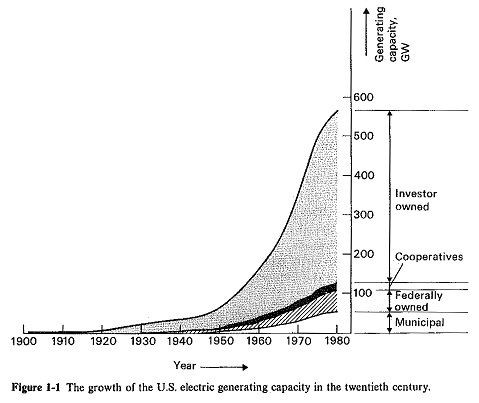Structure of U.S. Electric Utility Industry:
As noted from Fig. 1-1 the U.S. electric energy or power industry, more commonly known as the electric utility industry, is made up of four ownership segments, representing more than 3000 separate subsystems, which vary greatly in size. The private sector is the dominant one. The total cost of construction, operation, and maintenance is of such magnitudes that duplication cannot be afforded. The industry is thus in a sense a monopoly which, however, is closely regulated by federal and state agencies.
The Electric Utility Industry power systems of other nations have organizational and ownership structures that match their different political and economic systems.
Most of the systems are Electric Utility Industry interconnected into vast power grids which are subdivided into regional operating groups called power pools. Each individual power system within such a pool operates technically and economically independently, but is contractually tied to the other pool members in respect to certain generation and scheduling features.
It is obvious that the best geographical location of the generating plants would be close to the Electric Utility Industry load centers, i.e., the regions where the major energy demand exists. However, the locations of the primary conventional energy sources do not necessarily coincide with the nation’s population centers. We are therefore faced with the following choice:
- Build the power plants close to the energy sources and then transport the electric energy to the load centers.
- Build the power plants close to the load centers and transport the fuel from the source locality.
The electric power grid makes the first alternative technically feasible. However, in reality, the actual choice will be based upon a combination of technical, economical, and environmental factors. As we will see later, the voltage level of a transmission line determines its energy transmission capacity. By constantly increasing the voltage level and physical length of our transmission grid, we are developing a “superhighway system” for large blocks of electric energy that continuously widens our choice in this respect.
We summarize the advantages offered by pool operation:
- It permits the construction of larger and more economical generating units and the transmission of large blocks of energy from the generating sources to major load centers.
- It permits reduced reserve requirements by sharing of capacity between areas and sectors.
- It provides capacity savings by seasonal exchange of capacity between areas which have opposing winter and summer needs.
- It permits capacity savings from time zone and random diversity. (The peak. load in California occurs three hours later than in New York.)
- It facilitates transmission of off-peak energy.
- It provides the flexibility to meet unforeseen emergency demands.
